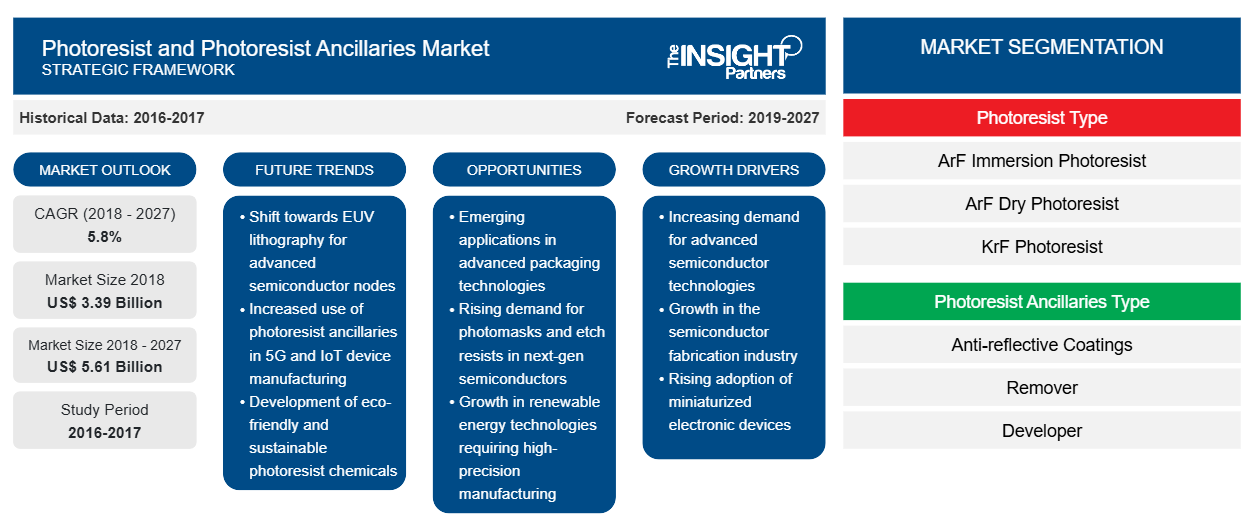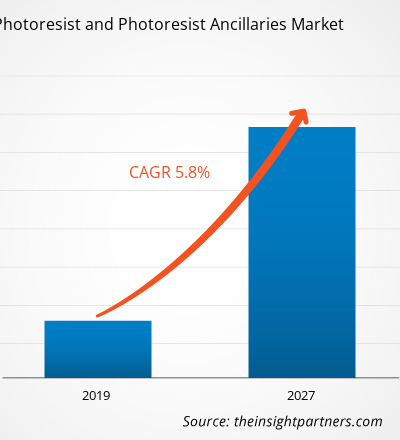2018 年光刻胶和光刻胶辅助设备市场价值为 33.9297 亿美元,预计到 2027 年将达到 56.1437 亿美元;预计 2019 年至 2027 年的复合年增长率为 5.8%。
光刻胶是一种感光聚合物树脂,主要用于生产印刷电路板、印刷板、平板液晶显示器、磁记录头和微机电系统 (MEMS)。这些组件用作掩蔽材料,用于通过蚀刻工艺将图像转移到底层基板中。光刻胶辅助材料是与光刻胶一起使用的材料,例如光刻胶剥离剂、抗反射涂层、显影剂和边缘珠去除剂。光刻胶和光刻胶辅助材料用于制造计算机、笔记本电脑、音乐播放器、电话、服务器和家用电器的多层半导体中的布线配置。电子行业在发达国家和发展中国家都面临着稳步增长。从事该领域的公司利用光刻胶和光刻胶辅助材料制造诸如高级电话、计算机系统、电视和家庭娱乐设备以及用于许多工业和科学应用的电子控制和监控设备等产品。
预计在预测期内,北美的复合年增长率最高,为 6.0%。多家国内外公司在北美站稳了脚跟。这些公司不断加强整体业务流程,以尽可能满足客户需求。多家国内外公司在北美地区站稳了脚跟。在北美地区,美国是光刻胶和光刻胶辅助设备的主要市场,其次是加拿大和墨西哥。
COVID-19 疫情于 2019 年 12 月首先在中国武汉爆发,此后迅速蔓延至全球。截至 2020 年 3 月,中国、意大利、伊朗、西班牙、韩国、法国、德国和美国是确诊病例和死亡人数最多的国家。根据世界卫生组织的最新数据,全球确诊病例约 332,930 例,死亡人数 14,510 例。由于封锁、旅行禁令和企业停业,COVID-19 疫情影响了各国的经济和行业。全球化学和材料行业是受疫情影响最大的行业之一,供应链中断、技术活动取消、办公室关闭等。例如,中国是全球制造业中心,也是各行业最大的原材料供应国。由于工厂关闭、供应链障碍和世界经济衰退, COVID-19 造成的整体市场崩溃也影响了光刻胶和光刻胶辅助设备市场的增长。
定制此报告以满足您的需求
您可以免费定制任何报告,包括本报告的部分内容、国家级分析、Excel 数据包,以及为初创企业和大学提供优惠和折扣
- 获取此报告的关键市场趋势。这个免费样品将包括数据分析,从市场趋势到估计和预测。
市场洞察
各种应用的需求不断增长,推动全球光刻胶和光刻胶辅助材料市场的发展
半导体和集成电路、液晶显示器和印刷电路板等各种应用领域的需求不断增长,推动着全球光刻胶和光刻胶辅助材料市场的发展。光刻胶和光刻胶辅助材料市场增长的关键因素之一是它们在平板显示器中的应用。由于这些显示器更薄、更轻、更节能,因此比其他显示器更受欢迎,从而刺激了美国、英国、意大利、中国、印度、俄罗斯、日本、墨西哥和加拿大等发达国家和发展中国家的市场增长。此外,光刻胶还用于多层半导体制造中的布线配置,而多层半导体制造是笔记本电脑、计算机、音乐播放器、手机、服务器和家用电器的重要组成部分。光刻胶是一种感光聚合物树脂,主要用于生产印刷电路板、印刷板、平板液晶显示器、磁记录头和微机电系统 (MEMS)。这些组件用作掩蔽材料,用于通过蚀刻工艺将图像转移到底层基板中。光刻胶辅助材料包括与光刻胶一起使用的光刻胶剥离剂、抗反射涂层、显影剂和边珠去除剂等材料。
应用程序洞察
根据应用,光刻胶和光刻胶辅助设备市场细分为 ArF 浸没式光刻胶、ArF 干式光刻胶、KrF 光刻胶以及 G 线和 I 线光刻胶。2018 年,ArF 浸没式光刻胶部分占全球光刻胶和光刻胶辅助设备市场的最大份额;然而,G 线和 I 线光刻胶部分预计在预测期内以更高的复合年增长率增长。它们被认为是显示临界尺寸 (CD) 均匀性的出色工艺窗口,可实现更好的产品轮廓形状。这些产品满足了越来越多城市中产阶级消费者的需求,他们愿意为光刻胶和光刻胶辅助设备支付高价。
光刻胶辅助材料类型洞察
根据光刻胶辅助设备类型,光刻胶和光刻胶辅助设备市场细分为抗反射涂层、去除剂、显影剂和其他。抗反射涂层部分占全球光刻胶和光刻胶辅助设备市场的最大份额;然而,预计去除剂部分在预测期内将实现最快的增长率。抗反射涂层属于光刻胶辅助设备产品级,有助于控制反射并在光刻过程中吸收光线。众所周知,它们具有多种有利特性,例如多重反射抑制和对比度改善。这些涂层直接有助于降低电子行业工艺的运营成本。抗反射涂层可帮助从传统的 365 纳米(I 线)工艺到尖端的 193 纳米浸没法。这些材料提供动态工艺窗口、宽光刻胶兼容性和所需的图案。
光刻胶和光刻胶辅助材料市场区域洞察
Insight Partners 的分析师已详细解释了预测期内影响光刻胶和光刻胶辅助设备市场的区域趋势和因素。本节还讨论了北美、欧洲、亚太地区、中东和非洲以及南美和中美洲的光刻胶和光刻胶辅助设备市场细分和地理位置。

- 获取光刻胶和光刻胶辅助材料市场的区域特定数据
光刻胶和光刻胶辅助材料市场报告范围
| 报告属性 | 细节 |
|---|---|
| 2018 年市场规模 | 33.9亿美元 |
| 2027 年市场规模 | 56.1亿美元 |
| 全球复合年增长率(2018 - 2027) | 5.8% |
| 史料 | 2016-2017 |
| 预测期 | 2019-2027 |
| 涵盖的领域 | 按光刻胶类型
|
| 覆盖地区和国家 | 北美
|
| 市场领导者和主要公司简介 |
|
市场参与者密度:了解其对商业动态的影响
光刻胶和光刻胶辅助材料市场正在快速增长,这得益于终端用户需求的不断增长,而这些需求又源于消费者偏好的不断变化、技术进步以及对产品优势的认识不断提高等因素。随着需求的增加,企业正在扩大其产品范围,进行创新以满足消费者的需求,并利用新兴趋势,从而进一步推动市场增长。
市场参与者密度是指在特定市场或行业内运营的企业或公司的分布情况。它表明在给定市场空间中,相对于其规模或总市场价值,有多少竞争对手(市场参与者)存在。
在光刻胶和光刻胶辅助设备市场运营的主要公司有:
- ALLRESIST GmbH
- DJ MicroLaminates, Inc.
- 杜邦公司
- 富士胶片控股株式会社
- JSR 公司
免责声明:上面列出的公司没有按照任何特定顺序排列。

- 了解光刻胶和光刻胶辅助设备市场顶级关键参与者概览
报告范围
全球光刻胶和光刻胶辅助材料市场 - 按光刻胶类型
- ArF 浸没式光刻胶
- ArF 干光刻胶
- KrF 光刻胶
- G线和I线光刻胶
全球光刻胶和光刻胶辅助设备市场 - 按光刻胶辅助设备类型
- 抗反射涂层
- 卸妆液
- 开发人员
- 其他的
全球光刻胶和光刻胶辅助材料市场 - 按应用
- 半导体和集成电路
- 液晶显示器
- 印刷电路板
- 其他的
公司简介
- 默克集团
- 住友化学株式会社
- 东京应化工业株式会社
- 微阻技术有限公司
- 信越化学工业株式会社
- ALLRESIST GmbH
- DJ Microlaminates, Inc.
- 杜邦公司
- 富士胶片公司
- JSR 公司
- 历史分析(2 年)、基准年、预测(7 年)及复合年增长率
- PEST 和 SWOT 分析
- 市场规模价值/数量 - 全球、区域、国家
- 行业和竞争格局
- Excel 数据集



Report Coverage
Revenue forecast, Company Analysis, Industry landscape, Growth factors, and Trends

Segment Covered
This text is related
to segments covered.

Regional Scope
North America, Europe, Asia Pacific, Middle East & Africa, South & Central America

Country Scope
This text is related
to country scope.
常见问题
Semiconductors and ICs segment is the leading segment in the forecast period. Growth and development in semiconductor industry in terms of display technology is expected to drive the growth of photoresist and photoresist ancillaries market. Photoresist materials are being extensively used in production of semiconductors and ICs components as they imprint the required circuitry to get ICs as the end product. Photoresist and ancillaries materials are utilized in high density packaging and wiring configuration in multi-layered semiconductor production, which are considered as an crucial parts of electronic devices. They are widely being used in consumer electronics such as smart phones, music players, household appliances, etc. and in other industrial processes.
The major players operating in the global photoresist and photoresist Ancillaries market are MERCK KGaA.; Sumitomo Chemical Co., Ltd; TOKYO OHKA KOGYO CO., LTD; Micro Resist Technology GmbH.; Shin-Etsu Chemical Co., Ltd; ALLRESIST GmbH; DJ Micro laminates, Inc.; DuPont de Nemours, Inc.; Fujifilm Corporation.; and JSR Corporation; among many others.
In 2018, the photoresist and photoresist ancillaries market was predominant in Asia Pacific at the global level. The APAC encompasses an ample amount of opportunities for the growth of photoresist and photoresist ancillaries. The region has been noticed as one of the prominent markets for the utilization of photoresist and photoresist ancillaries. China is dominating the regional market, followed by other countries such as Japan, Taiwan, Vietnam, Korea, Thailand, Malaysia, and Indonesia. These countries are experiencing rising demand from the semiconductors and ICs, LCDs, printed circuit boards, and others. Apart from its application in the semiconductors industry, photoresist and photoresist ancillaries are extensively utilized in the wearable devices, smart phones, and other electronic devices. The demand for smart phones and wearable devices has increased subsequently with the growth of the electronics industry, along with a shift in consumer living standards. This shift has propelled the growth of the market in the region
Trends and growth analysis reports related to Chemicals and Materials : READ MORE..
The List of Companies - Photoresist and Photoresist Ancillaries Market
- ALLRESIST GmbH
- DJ MicroLaminates, Inc.
- DuPont de Nemours, Inc.
- FUJIFILM Holdings Corporation
- JSR Corporation
- Shin-Etsu Chemical Co., Ltd.
- Tokyo Ohka Kogyo Co., Ltd
- Micro Resist Technology GmbH
- Merck KGaA
- Sumitomo Chemical Co., Ltd.
The Insight Partners performs research in 4 major stages: Data Collection & Secondary Research, Primary Research, Data Analysis and Data Triangulation & Final Review.
- Data Collection and Secondary Research:
As a market research and consulting firm operating from a decade, we have published and advised several client across the globe. First step for any study will start with an assessment of currently available data and insights from existing reports. Further, historical and current market information is collected from Investor Presentations, Annual Reports, SEC Filings, etc., and other information related to company’s performance and market positioning are gathered from Paid Databases (Factiva, Hoovers, and Reuters) and various other publications available in public domain.
Several associations trade associates, technical forums, institutes, societies and organization are accessed to gain technical as well as market related insights through their publications such as research papers, blogs and press releases related to the studies are referred to get cues about the market. Further, white papers, journals, magazines, and other news articles published in last 3 years are scrutinized and analyzed to understand the current market trends.
- Primary Research:
The primarily interview analysis comprise of data obtained from industry participants interview and answers to survey questions gathered by in-house primary team.
For primary research, interviews are conducted with industry experts/CEOs/Marketing Managers/VPs/Subject Matter Experts from both demand and supply side to get a 360-degree view of the market. The primary team conducts several interviews based on the complexity of the markets to understand the various market trends and dynamics which makes research more credible and precise.
A typical research interview fulfils the following functions:
- Provides first-hand information on the market size, market trends, growth trends, competitive landscape, and outlook
- Validates and strengthens in-house secondary research findings
- Develops the analysis team’s expertise and market understanding
Primary research involves email interactions and telephone interviews for each market, category, segment, and sub-segment across geographies. The participants who typically take part in such a process include, but are not limited to:
- Industry participants: VPs, business development managers, market intelligence managers and national sales managers
- Outside experts: Valuation experts, research analysts and key opinion leaders specializing in the electronics and semiconductor industry.
Below is the breakup of our primary respondents by company, designation, and region:

Once we receive the confirmation from primary research sources or primary respondents, we finalize the base year market estimation and forecast the data as per the macroeconomic and microeconomic factors assessed during data collection.
- Data Analysis:
Once data is validated through both secondary as well as primary respondents, we finalize the market estimations by hypothesis formulation and factor analysis at regional and country level.
- Macro-Economic Factor Analysis:
We analyse macroeconomic indicators such the gross domestic product (GDP), increase in the demand for goods and services across industries, technological advancement, regional economic growth, governmental policies, the influence of COVID-19, PEST analysis, and other aspects. This analysis aids in setting benchmarks for various nations/regions and approximating market splits. Additionally, the general trend of the aforementioned components aid in determining the market's development possibilities.
- Country Level Data:
Various factors that are especially aligned to the country are taken into account to determine the market size for a certain area and country, including the presence of vendors, such as headquarters and offices, the country's GDP, demand patterns, and industry growth. To comprehend the market dynamics for the nation, a number of growth variables, inhibitors, application areas, and current market trends are researched. The aforementioned elements aid in determining the country's overall market's growth potential.
- Company Profile:
The “Table of Contents” is formulated by listing and analyzing more than 25 - 30 companies operating in the market ecosystem across geographies. However, we profile only 10 companies as a standard practice in our syndicate reports. These 10 companies comprise leading, emerging, and regional players. Nonetheless, our analysis is not restricted to the 10 listed companies, we also analyze other companies present in the market to develop a holistic view and understand the prevailing trends. The “Company Profiles” section in the report covers key facts, business description, products & services, financial information, SWOT analysis, and key developments. The financial information presented is extracted from the annual reports and official documents of the publicly listed companies. Upon collecting the information for the sections of respective companies, we verify them via various primary sources and then compile the data in respective company profiles. The company level information helps us in deriving the base number as well as in forecasting the market size.
- Developing Base Number:
Aggregation of sales statistics (2020-2022) and macro-economic factor, and other secondary and primary research insights are utilized to arrive at base number and related market shares for 2022. The data gaps are identified in this step and relevant market data is analyzed, collected from paid primary interviews or databases. On finalizing the base year market size, forecasts are developed on the basis of macro-economic, industry and market growth factors and company level analysis.
- Data Triangulation and Final Review:
The market findings and base year market size calculations are validated from supply as well as demand side. Demand side validations are based on macro-economic factor analysis and benchmarks for respective regions and countries. In case of supply side validations, revenues of major companies are estimated (in case not available) based on industry benchmark, approximate number of employees, product portfolio, and primary interviews revenues are gathered. Further revenue from target product/service segment is assessed to avoid overshooting of market statistics. In case of heavy deviations between supply and demand side values, all thes steps are repeated to achieve synchronization.
We follow an iterative model, wherein we share our research findings with Subject Matter Experts (SME’s) and Key Opinion Leaders (KOLs) until consensus view of the market is not formulated – this model negates any drastic deviation in the opinions of experts. Only validated and universally acceptable research findings are quoted in our reports.
We have important check points that we use to validate our research findings – which we call – data triangulation, where we validate the information, we generate from secondary sources with primary interviews and then we re-validate with our internal data bases and Subject matter experts. This comprehensive model enables us to deliver high quality, reliable data in shortest possible time.


 获取此报告的免费样本
获取此报告的免费样本